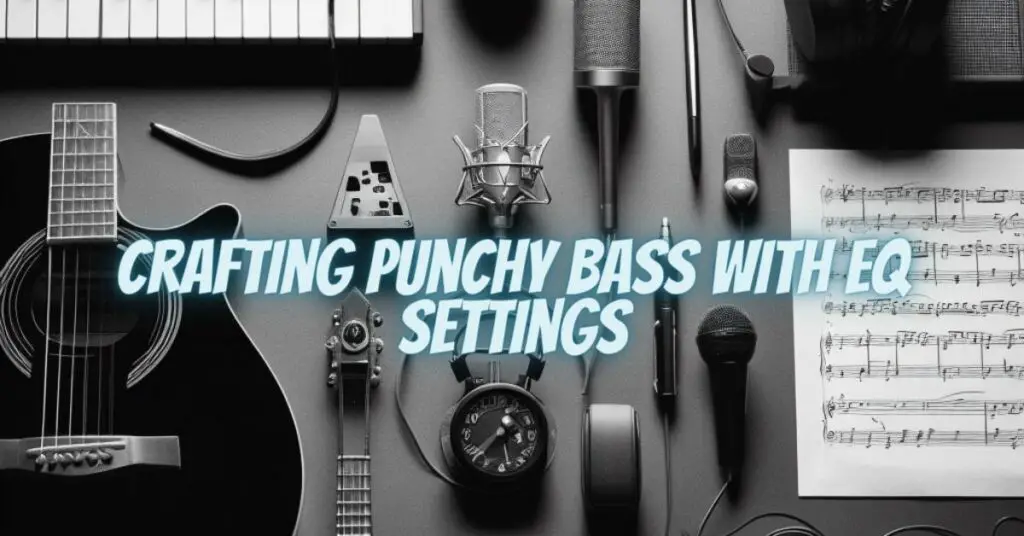In the world of audio production, achieving a punchy bass is essential for creating music that captivates the listener. A punchy bass not only provides the groove and energy but also makes the whole track come alive. One of the most critical tools at your disposal for shaping the bass’s punch is equalization (EQ). In this article, we’ll explore the art and science of crafting punchy bass EQ settings to elevate your mixes and make your low-end truly stand out.
The Quest for Punchy Bass
Before diving into the specifics of EQ settings, it’s crucial to understand what we mean by “punchy” bass. Punchy bass is characterized by a tight and well-defined low-end that cuts through the mix with authority. It delivers impact and presence without muddying up the other elements of the track. Achieving punchy bass involves a combination of factors, including the choice of instrument, arrangement, playing technique, and, of course, EQ.
Crafting Punchy Bass EQ Settings
- Start with a Clean Signal: Ensure that your bass track is recorded or synthesized cleanly without excessive noise or unwanted artifacts. A clean source signal is essential for crafting a punchy bass.
- High-Pass Filtering: Apply a high-pass filter to eliminate any unnecessary low-frequency content, removing rumble and muddiness below the desired bass range (typically around 20-40 Hz). This step ensures that the low-end frequencies you boost with EQ are intentional.
- Boost the Fundamental Frequency: To make the bass punch through the mix, focus on boosting the fundamental frequency of the bass, which is typically in the 40-80 Hz range. A moderate boost in this region can add weight and impact to the bass sound.
- Shape the Upper Harmonics: Beyond the fundamental frequency, enhancing the upper harmonics (around 80-200 Hz) can bring clarity and definition to the bass. This adds character and allows the bass to cut through the mix without overpowering it.
- Cut Unwanted Frequencies: Use subtractive EQ to identify and reduce frequencies that contribute to muddiness or mask the punchiness of the bass. Common problematic areas are around 100-250 Hz. A slight cut in these regions can clean up the mix.
- Embrace Dynamic EQ: To maintain the punch while controlling unruly peaks, consider using dynamic EQ. This allows you to tame transients and resonances in real-time without affecting the overall tonal balance.
- Reference and A/B Testing: Regularly reference your mix on different playback systems to ensure that your punchy bass translates well across various platforms. A/B testing against professionally mixed tracks can also help refine your EQ choices.
- Complement with Compression: After setting your punchy bass EQ, consider applying compression to further control dynamics and enhance the overall consistency of the low end.
Genre Considerations
The quest for punchy bass is genre-dependent. Different styles of music may require distinct approaches to bass EQ settings. For example, in a modern hip-hop track, a pronounced and hard-hitting bass is essential, while in a jazz recording, a more subtle and rounded bass tone may be desired. Always consider the specific requirements of the genre you’re working in.
Room Acoustics and Monitoring
Just like in our previous article on bass EQ, room acoustics and monitoring systems are paramount when dialing in punchy bass EQ settings. Room resonances and standing waves can deceive your perception of low-end frequencies. Thus, investing in acoustic treatment and high-quality studio monitors can help ensure accurate EQ decisions.
Crafting punchy bass EQ settings is an art that combines technical knowledge with artistic intuition. It involves a delicate balance of boosting fundamental frequencies, shaping upper harmonics, cutting unwanted frequencies, and using dynamic EQ when needed. Achieving punchy bass is not a one-size-fits-all endeavor; it varies based on the genre and the mix’s specific requirements. So, experiment, trust your ears, and don’t be afraid to fine-tune your EQ settings to create a bass that truly packs a punch and elevates your music to new heights.

